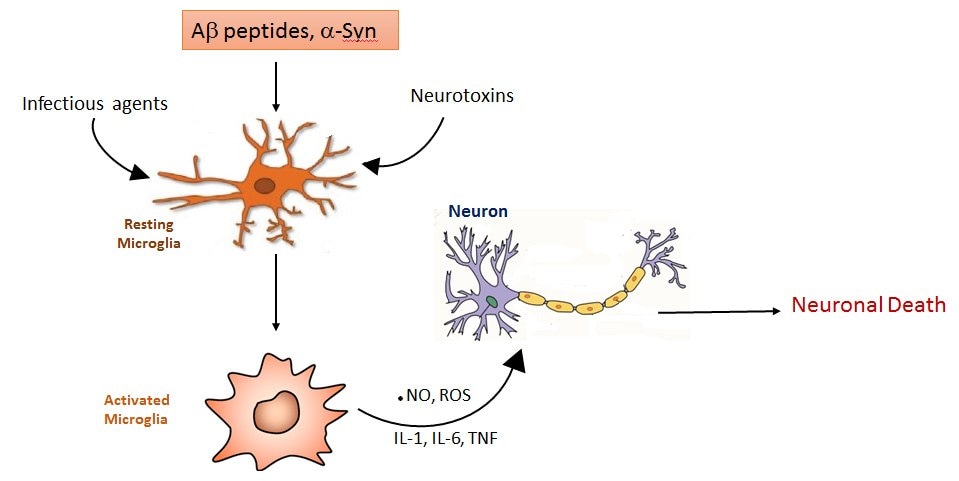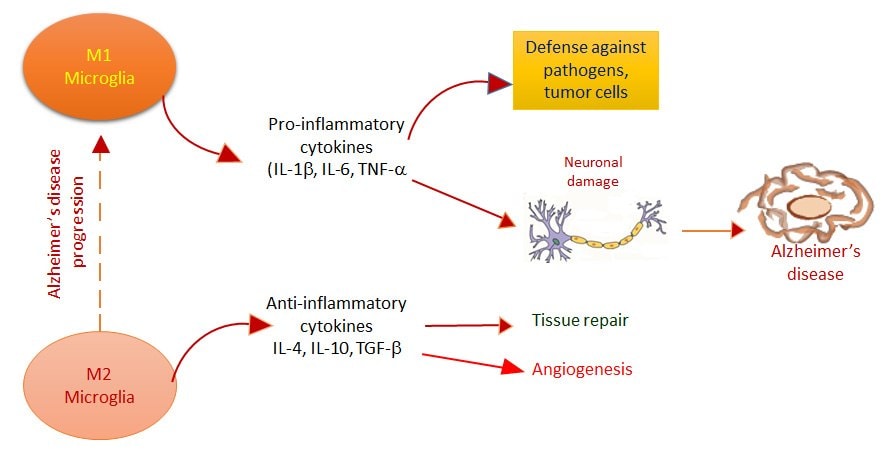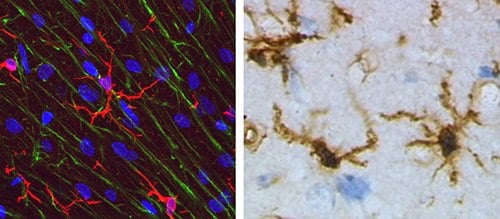Acute and Chronic Inflammation: Microglia in Neuroprotection and Neurodegeneration
Chandra Mohan, Ph.D.
Temecula, CA
The term neurodegeneration characterizes a chronic loss of neuronal structure and function leading to progressive mental impairments. The incidence of neurodegeneration generally increases with age. However, infectious agents may also induce neuronal death via apoptosis. Years of research have linked neurodegeneration to the phenomenon of neuroinflammation, which could be caused by microvascular damage, atherosclerosis, age-associated pro-inflammatory signals, and viral or bacterial infections that compromise the blood-brain barrier.
It has been established that any neurological damage or disorder can lead to inflammation, which results in activation of microglia, the resident tissue macrophages of the central nervous system. Microglial activation is followed by proliferation and change in phenotype. Acute neuronal damage resulting from stroke, hypoxia, and neurotrauma can compromise neuronal survival and indirectly trigger neuroinflammation. In these cases, microglia are activated in response to the insult and adopt a phagocytic phenotype accompanied by the release of inflammatory mediators such as cytokines and chemokines. This may be considered a protective response intended to limit further injury and initiate repair processes.

Figure 1.Microglia-mediated neuroinflammation. Peptides that comprise amyloid plaques (Aβ peptides) characteristic of Alzheimer’s disease, other neurotoxins, or infectious agents may initiate activation signals in resting microglia, the tissue-resident macrophages of the CNS. Conversion to the activated microglial phenotype is often accompanied by the release of NO and reactive oxygen species (ROS), along with production of inflammatory cytokines such as IL-1, IL-6, and tumor necrosis factors (TNF). This inflammatory milieu creates a toxic environment that leads to neuronal dysfunction and death.
Microglia are located throughout the brain and spinal cord and may account for up to 15% of all cells in the brain. They are the first responders in active immune defense in the central nervous system. Their protective functions include scavenging infectious agents, plaques, and damaged or superfluous neurons and synapses, to prevent potentially fatal damage. Microglia play several crucial roles during brain development. They contribute to numerical control of neuronal cells by inducing apoptosis of specific neuronal subpopulations. They support synaptogenesis through the local synthesis of neurotrophic factors, and regulate synaptic transmission and remodeling. However, microglia may also play a detrimental role for neurons when they gain a chronic inflammatory function and promote neuropathologies.
Neurodegenerative diseases, such as Alzheimer’s disease, Parkinson’s disease, and multiple sclerosis cause chronic neuroinflammation that persists long after an initial injury or insult and results in long-standing activation of microglia and sustained release of inflammatory mediators. These molecules increase oxidative stress and perpetuate the inflammatory cycle, activating additional microglia and promoting their proliferation. This results in further release of inflammatory factors.
During Alzheimer’s disease progression, microglia activation can reduce the levels of Aβ peptides via phagocytosis, clearance, and degradation, or release pro-inflammatory cytokines that can contribute to neuronal damage and loss. Generally, under physiological conditions, active microglia maintain homoeostasis and play a role in neuroprotection and repair by releasing growth factors, such as BDNF and TGF-β. Under pathological conditions such as infection, injury, and ischemia, however, they are activated, proliferate, and assume a macrophage-like morphology.

Figure 2.Microglia Neuroinflammation
Activated microglia exert a variety of effects which may be either neurotoxic or neuroprotective. For example, microglia activated by lipopolysaccharides, IFN-γ or TNF-α, are known as the M1 or classically activated type, and they play a vital role in the defense against pathogens and tumor cells by producing pro-inflammatory cytokines, such as IL-1β, TNF-α, and free radicals. However, the alternative M2 type of microglia have an anti-inflammatory phenotype, which promote tissue remodeling and repair and angiogenesis via the release of anti-inflammatory cytokines such as IL-4, and IL-10 and diminished levels of pro-inflammatory cytokines. In murine models of Alzheimer’s disease, an increase in both M1 and M2 microglia have been reported compared to their age-matched controls; with the progression of disease microglia have been shown to switch from M2 to an M1 phenotype. The NALP3 (NLRP3) inflammasome, a mediator of IL-1β production, plays an important role in driving the innate immune response towards Aβ peptides, and blocking NALP3 activity can induce microglial phagocytosis and a shift towards the M2 phenotype.

Figure 3.Microglia resident in the brain regulate neuroinflammation. Left, microglia stained with anti-Iba1 (red). Green, Bergmann glial processes. Blue, nuclei. Right, microglia stain brown with lectins. Nuclei are stained blue with hematoxylin. (images: Wikimedia commons)
Early expression of pro-inflammatory cytokines in Alzheimer’s disease brain by non-neuronal cells, including endothelial cells, can also play a role in the development of disease because microvessels in the diseased brain can release high amounts of pro-inflammatory cytokine compared with their healthy age-matched controls. In addition, sustained inflammation from the periphery may also contribute to uptake of pro-inflammatory cytokines in the brain, mediated by the receptor for advanced glycation endproducts (RAGE) and compromise of the blood-brain barrier.
The study of these cells dedicated to protection of the central nervous system by regulating inflammatory responses in this highly immune-privileged environment is critical to our understanding of neurodegeneration, as well as infection and trauma in the brain. Enhanced understanding of microglial physiology and phenotypes, and the increasing evidence supporting the role of inflammatory cytokines and other microglia-mediated neuroinflammation may lead to newer therapeutic approaches for treatment of stroke and debilitating neurodegenerative diseases.
Materials
To continue reading please sign in or create an account.
Don't Have An Account?